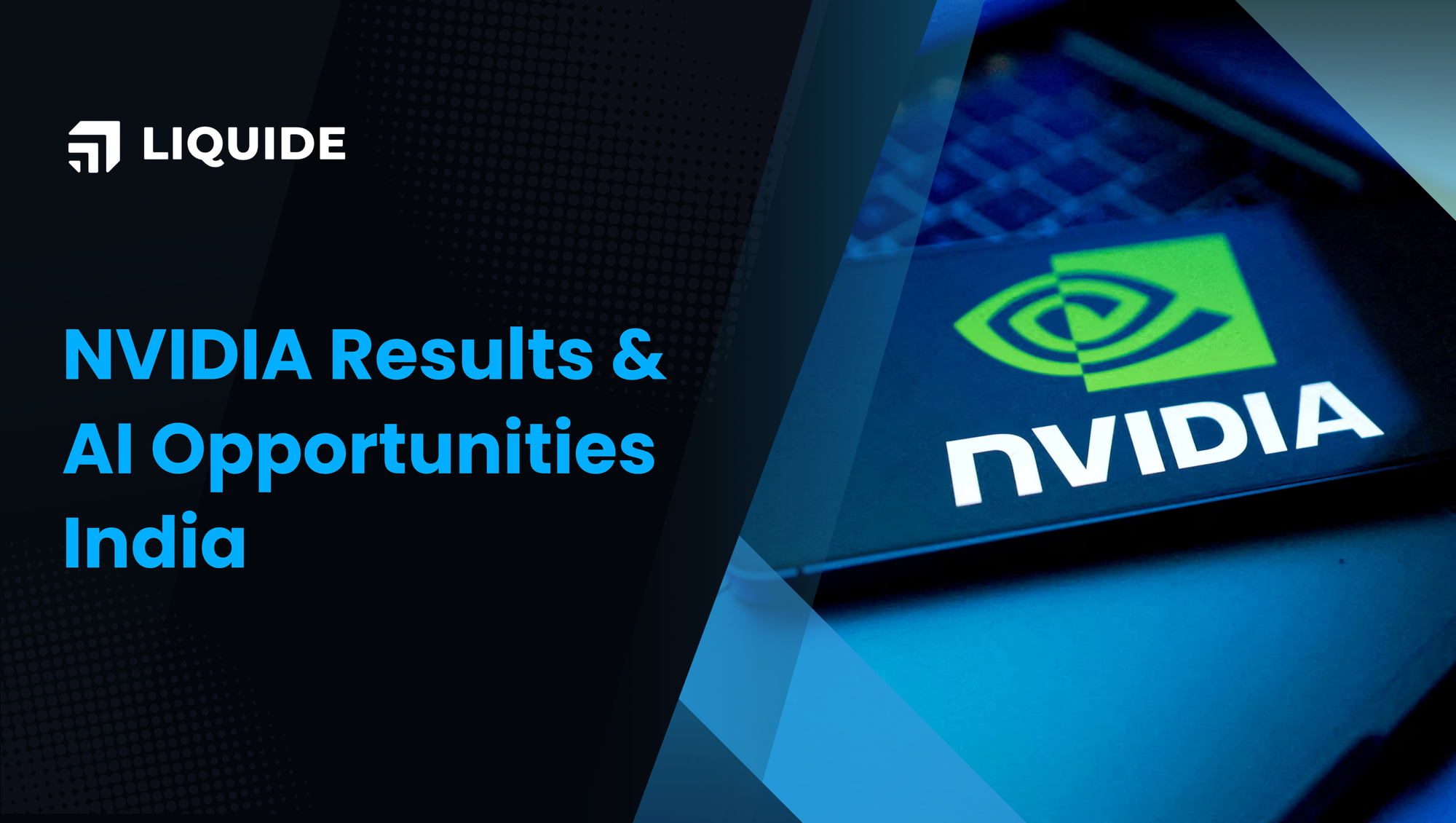NVIDIA Breaks Records: Is India’s Tech About to Explode or Pop?
NVIDIA’s blockbuster earnings have ignited global market optimism and pushed equities toward record highs. But beneath the AI euphoria lies a crucial dilemma for Indian investors: Is this a massive multi-trillion-dollar opportunity or the elephant in the room that markets seem to be ignoring?

NVIDIA has once again shattered expectations, posting blockbuster numbers that have sent a surge of optimism across global markets. Japan’s Nikkei rallied almost 3% in reaction and India’s Nifty 50 climbed toward record territory as investors turned decisively risk-on.
This story goes far beyond one company beating analyst estimates. NVIDIA’s results highlight the scale and speed at which the AI economy is accelerating—fuelling demand for chips, data centres, cloud infrastructure and high-performance computing around the world. But the real questions is— can this momentum sustain?
Here’s why that matters and why Indian investors should be paying close attention to the ripple effects, not just the stock price.
The Engine Behind a Global AI Wave
NVIDIA notched an astonishing $57 billion in revenue for Q3 FY2026 (ended October 26, 2025), marking a 62% jump from last year and a healthy 22% bump quarter-on-quarter. Most of this growth comes from their data-centre (AI compute) segment, which hit $51.2 billion—up 66% year-on-year and 25% quarter-on-quarter.
For those wondering whether the party’s just getting started, NVIDIA’s forecast for the next quarter is a solid $65 billion in revenue, well above what most analysts were expecting.
Margins: Big, Bold & Still Expanding
NVIDIA is operating with gross margins above 73% and net income has climbed more than 65% over the past year. Such margins aren’t common in the tech world and showcase NVIDIA’s iron grip on pricing (with ~90% market share in AI chips!). This kind of profitability is rarely seen outside monopoly situations—and markets are loving it so far.
What’s Driving This Growth?
- AI infrastructure demand is at full throttle, with NVIDIA’s new “Blackwell” architecture generating serious buzz as a generational leap in computing power.
- A big chunk of NVIDIA’s income comes from data centres, which means every time a tech company expands its AI capabilities, NVIDIA’s chips are likely involved.
- Segments like automotive and robotics are scaling rapidly too, with new EVs and corporate automation projects tapping into NVIDIA’s expertise.
Why Everyone Feels the NVIDIA Effect
When NVIDIA posts a blowout quarter, tech-heavy indexes like the NASDAQ and S&P 500 often surge in response—thanks to the company’s enormous index weight. The “NVIDIA effect” is now so powerful that a single earnings print can shift sentiment on Wall Street and send ripples across European and Asian markets.
With its market cap now inching toward $5 trillion, NVIDIA has become a barometer for the entire AI economy. Its results are seen as a real-time snapshot of where the future of technology and capital is heading — which is why every major economy is watching each quarter like a global event, not just a corporate update.
Opportunity & the Elephant in the Room
Management pegs the total AI infrastructure opportunity at an astonishing $3-4 trillion over the next five years. Huge runway, huge excitement. But let’s keep it real—there are risks:
- The current valuation is steep, loading up the share price with very high growth expectations—which means heightened volatility if momentum stalls.
- A hiccup in data centre investments—or changes in government policy—would send shockwaves not just through Silicon Valley, but across global tech and capital markets. While the demand for new data centres is red-hot now, scepticism creeps in about just how many will be needed 5–10 years down the line, what hardware they’ll actually run and whether sky-high margins can be sustained as competition ramps up.
- Export restrictions (especially US-China tensions) could take a bite out of revenue in key geographies.
Beyond the Stock: India’s Stake in NVIDIA’s Success
NVIDIA’s blowout quarter has sent global markets into celebration mode, but it is worth remembering that every rally carries risks beneath the surface. For now, enthusiasm around AI is overwhelming and concerns have been pushed aside—but they will resurface eventually.
And because what happens on Wall Street inevitably spills into other markets as well (including ours), Indian investors would do well to carry some armour—or at least position themselves where the downside is limited.
Another point to keep an eye on: a significant chunk of AI spending by global tech giants is being funded through debt. Companies are borrowing heavily and burning cash to stay in the race and credit spreads across big tech are already widening. That’s usually an early sign that risk is building. So blindly jumping into anything with an “AI” tag may not be the smartest move right now.
AI is a multi-year structural story, not a one-quarter trade. Rather than riding hype cycles, spotting undervalued Indian beneficiaries of the AI and semiconductor ecosystem could be a far more strategic way to participate in the opportunity.
For investors, the real question becomes: How do I position my portfolio to participate in the long-term AI and semiconductor opportunity— where India becomes a key contributor, not just a consumer?” Because that’s where the real value lies.
So, What Should Indian Investors Actually Do?
- Use Corrections, not Euphoria, to Build Positions
Parabolic moves often correct sharply. Building exposure gradually during pullbacks can create far better risk-reward than chasing peaks.
- Focus on Enablers, not Hype Tickers
Diversify within the theme. Look for Indian companies building the infrastructure behind AI—data centres, cloud services, semiconductor supply chain, industrial automation and power/renewables supporting energy-hungry AI workloads.
- Track Capex Cycles Carefully
Companies with strong balance sheets and disciplined capital allocation will outlast those burning cash to stay relevant. Avoid firms heavily dependent on debt-funded AI investments.

